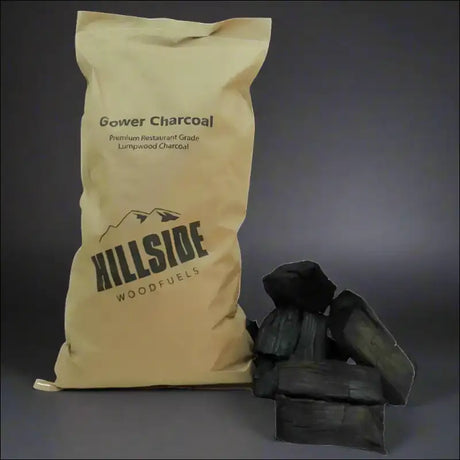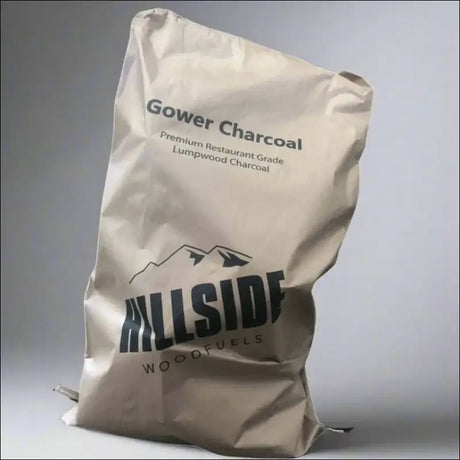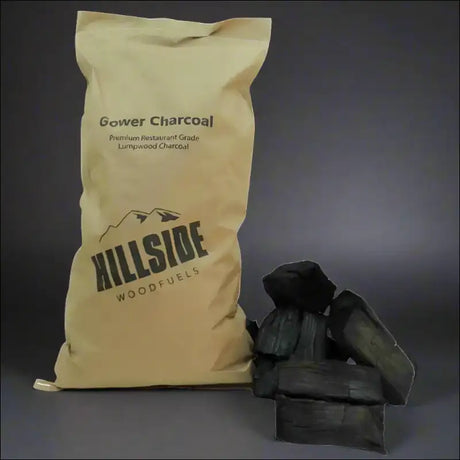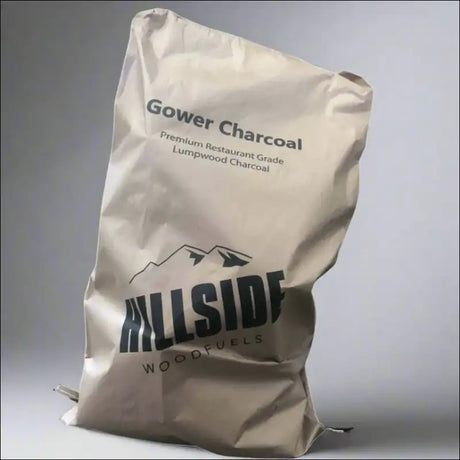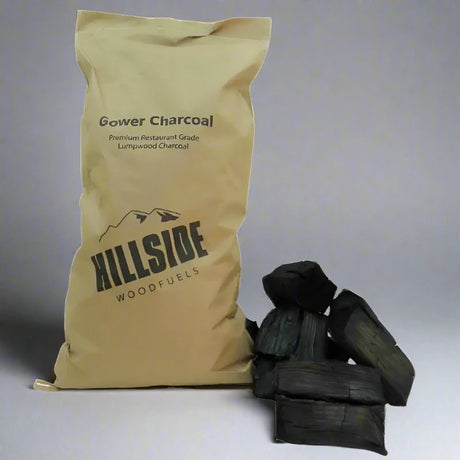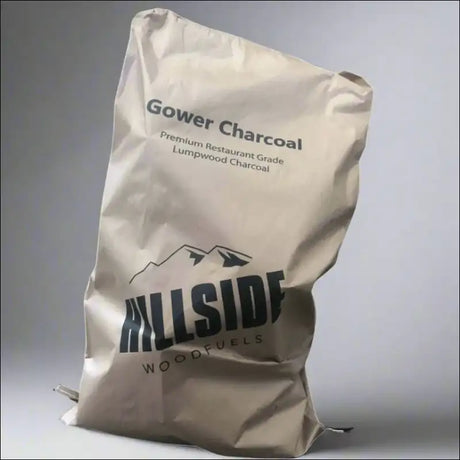Understanding Lump Charcoal and Its Environmental Impact

Defining Lump Charcoal
When you're setting up your outdoor kitchen, understanding the fuel you use is crucial. Lump charcoal is a favorite among grilling enthusiasts for its ability to provide a high heat and impart a pure, smoky flavor to your food. Unlike briquettes, lump charcoal is made from hardwood without any additives, resulting in a product that's all-natural and contains less ash.
Grill safely with lumpwood charcoal: ventilate, keep distance from flammables, use long tools, let charcoal cool. Optimize grilling with ash-covered charcoal, strategic placement, and airflow for restaurant-quality flavors.
Here's a quick list to help you identify lump charcoal:
- It's typically made from hardwood species like oak, hickory, or maple.
- The pieces vary in size and shape, as they are natural wood chunks.
- Lights faster and burns hotter than other charcoal types.
- Produces minimal ash, making cleanup easier after cooking.
Comparison with Other Charcoal Types
When you're considering lump charcoal for your outdoor kitchen, it's important to understand how it stacks up against other types of charcoal. Lump charcoal is known for its purity and ability to burn hotter and cleaner than briquettes, which often contain additives and binders. Here's a quick comparison to help you grasp the differences:
- Lump charcoal: Pure wood, lights quickly, burns hotter, leaves less ash.
- Briquettes: Uniform shape, burns longer, contains additives, more ash production.
While briquettes may be more consistent in size and burn time, lump charcoal's natural composition makes it a preferred choice for those seeking a more authentic grilling experience with a reduced environmental footprint.
Opting for lump charcoal can be a step towards a more sustainable outdoor kitchen, as it typically involves fewer chemicals and produces less waste.
Remember, the choice of charcoal can influence not only the flavor of your food but also the sustainability of your cooking practices. Consider the impact of your choice on the environment as you aim for that perfect sear on your steaks.
Carbon Footprint of Lump Charcoal Production
When considering the environmental impact of your outdoor kitchen, the carbon footprint of lump charcoal production cannot be overlooked. Unlike sustainable wood or smoke-free alternatives, traditional charcoal production has been linked to deforestation and pollution. However, not all charcoal is created equal.
The choices you make in sourcing your lump charcoal can have significant implications for the environment.
Here are some factors that contribute to the carbon footprint of lump charcoal:
- The type of wood used and its source
- The efficiency of the charcoal production process
- The distance the charcoal travels from production to market
Understanding these factors can help you make more informed decisions about the charcoal you use. Remember, embracing alternatives like the Tawi stove can help reduce your carbon footprint and combat climate change.
Sustainable Practices in Lump Charcoal Production

Sourcing Responsibly Grown Wood
When you're looking to enhance your outdoor kitchen with a sustainable touch, the choice of fuel is paramount. Opting for lumpwood charcoal ensures that you're using a product derived from responsibly managed forests. Unlike traditional charcoal, which may come from questionable sources, restaurant grade lumpwood charcoal is often produced with sustainability in mind.
- Sustainably sourced: Ensures the wood comes from forests managed with long-term health in mind.
- Chemical-free: No harmful additives, providing a natural taste to your BBQ.
- Large hardwood pieces: Offers a longer burn time and consistent heat.
By choosing restaurant grade lumpwood charcoal, you're not only getting superior BBQ flavor but also contributing to a healthier environment. This charcoal is recognized for its long burn time and consistency, making it a prime choice for eco-conscious outdoor cooking enthusiasts.
Remember, the impact of your outdoor kitchen goes beyond the immediate pleasure of a flavorful meal. It's about making informed choices that align with your values of preserving nature. By selecting lumpwood charcoal, especially of the restaurant grade, you're taking a step towards a more sustainable lifestyle.
Energy-Efficient Manufacturing Techniques
When you're exploring the world of sustainable outdoor cooking, it's crucial to consider the manufacturing techniques behind your lump charcoal. Energy-efficient methods not only reduce the environmental footprint but also ensure that the charcoal you use is a product of conscious efforts to protect our planet.
- Retort Kilns: These advanced kilns capture and reuse gases that are emitted during the charcoal-making process, leading to a significant reduction in energy use and emissions.
- Solar Power: Some manufacturers harness solar energy to power parts of the production process, further minimizing reliance on fossil fuels.
- Waste Heat Recovery: Implementing systems to reclaim and utilize waste heat from the production process can dramatically improve energy efficiency.
By adopting these energy-efficient manufacturing techniques, producers of lump charcoal are taking meaningful steps towards a more sustainable practice, aligning with the values of eco-conscious consumers like you.
Certifications and Standards for Sustainability
When you're committed to sustainable outdoor cooking, understanding the certifications and standards for lump charcoal is crucial. These benchmarks ensure that the products you use meet specific environmental and ethical criteria. Here's what to look for:
- FSC Certification: Indicates the wood used comes from responsibly managed forests.
- Rainforest Alliance Certified: Ensures sustainable farming practices and conservation of natural resources.
- EcoLogo: Identifies products with reduced environmental impact.
By choosing lump charcoal with these certifications, you're not only contributing to a healthier environment but also supporting sustainable practices in the industry.
Remember, certifications are a testament to the manufacturer's commitment to sustainability. They often involve rigorous assessments and continuous monitoring to maintain standards. So, when you see these labels, you can feel confident about the sustainability of your outdoor kitchen's fuel source.
Integrating Lump Charcoal into Outdoor Kitchens

Designing for Efficiency and Sustainability
When integrating lump charcoal into your outdoor kitchen, efficiency and sustainability should be at the forefront of your design. Opt for appliances that are known for their low emissions and high heat retention. This not only reduces the amount of charcoal needed but also minimizes the environmental impact.
- Choose insulated grills and smokers to maintain temperature
- Select adjustable air vents for better heat control
- Invest in a chimney starter for efficient charcoal ignition
By focusing on efficient design, you can ensure that your outdoor cooking experiences are both enjoyable and environmentally responsible.
Remember, the goal is to create a space that not only serves your culinary needs but also respects the planet. Regular maintenance and proper cleaning of your equipment will extend its lifespan and performance, further contributing to a sustainable outdoor kitchen.
Choosing the Right Equipment
When integrating lump charcoal into your outdoor kitchen, selecting the right equipment is crucial for both efficiency and sustainability. Opt for appliances that are designed to work optimally with lump charcoal, ensuring that you get the most out of its high-heat and long-burn properties. Here's a quick guide to help you make informed choices:
- Grills and Smokers: Look for models with adjustable air vents for better temperature control.
- Chimney Starters: A must-have for lighting charcoal efficiently without the need for lighter fluid.
- Heat-Resistant Tools: Invest in quality utensils that can handle the high temperatures of charcoal grilling.
Remember, the goal is to achieve BBQ perfection by using hardwood charcoal, arranging it in a pyramid shape, and following proper lighting techniques. A chimney starter can be particularly helpful in this process.
Lastly, consider the size and portability of the equipment if you plan to move it around or store it when not in use. Durability is also key; choose items that will stand the test of time and weather.
Maintenance and Upkeep of Charcoal-Fueled Appliances
Proper maintenance of your charcoal-fueled appliances is crucial for both performance and longevity. Regular cleaning ensures that your outdoor kitchen remains a safe and enjoyable place to cook. Begin by routinely emptying ash and unburnt charcoal, as these can impede airflow and affect cooking temperatures.
To maintain your equipment, follow these simple steps:
- Inspect your grill before each use for any signs of wear or damage.
- Clean the grates after every use to prevent food buildup and to maintain a non-stick surface.
- Cover your grill when not in use to protect it from the elements.
Remember, the type of fuel you use can also impact maintenance needs. For instance, lump charcoal typically produces less ash than briquettes, making cleanup easier. However, always refer to the manufacturer's guidelines, as some appliances, like the Boss Grill, may have specific requirements for the type of fuel used.
Consistent care and attention to detail will not only prolong the life of your charcoal appliances but also enhance your outdoor cooking experience.
Consumer Choices and Lump Charcoal Usage

Understanding Product Labels and Descriptions
When you're selecting lump charcoal for your outdoor kitchen, the product label is your first point of contact with the manufacturer's claims. It's essential to verify sourcing and consider the type of wood used, as these factors significantly impact both the flavor of your food and the sustainability of the product. Look for labels that clearly state the origin of the wood and whether it's been responsibly sourced.
Here's a quick checklist to help you interpret product labels:
- Ensure the charcoal is made from natural, pure hardwood without additives.
- Check for sustainability certifications or eco-friendly claims.
- Understand the heat management properties of the charcoal, as different woods burn at varying temperatures.
By prioritizing sustainability and being informed about the wood types and heat management, you can enhance the flavor of your grilling experience while supporting ethical sourcing practices.
Remember, the right product label doesn't just inform; it also reflects the manufacturer's commitment to quality and environmental responsibility. As a consumer, your choices can drive the demand for more sustainable outdoor cooking solutions.
The Role of Customer Reviews in Informed Decisions
When venturing into the world of sustainable outdoor cooking, customer reviews become a compass for navigating the myriad of product choices. Reviews offer insights into the performance and reliability of lump charcoal brands, often highlighting aspects such as flavor enhancement, heat consistency, and cooking time reduction. For instance, restaurant-grade charcoal is praised for its ability to enhance flavor and provide consistent heat, which can ultimately reduce cooking time.
Before making a purchase, consider the following points derived from customer feedback:
- The type of charcoal that suits your culinary needs, such as lump charcoal or coconut shell charcoal.
- The ease of use and lighting of the charcoal.
- The longevity of the burn and the temperature control it allows.
- The environmental impact of the charcoal, including its production and sourcing.
Making an informed decision requires weighing the collective experiences of others against your personal preferences and sustainability goals.
Remember, while reviews are a valuable resource, they should be one of many factors in your decision-making process. Always cross-reference with product descriptions, certifications, and your own requirements for a sustainable outdoor kitchen.
Addressing Common Questions and Misconceptions
When it comes to outdoor cooking, lump charcoal is often preferred for its ability to impart an authentic smoky flavor. However, there are common questions and misconceptions that may arise among consumers. For instance, the belief that lump charcoal cannot be used in certain grills is widespread. Yet, as clarified by product specialists, lump charcoal is indeed compatible with a variety of grills, including those that may not explicitly mention it in their manuals.
To ensure you're getting the most out of your lump charcoal, consider these tips:
- Control the temperature by adjusting air vents.
- Add wood chips for enhanced flavor.
- Regularly maintain your grill to preserve its condition and performance.
Misinformation can lead to underutilization of lump charcoal's potential in outdoor kitchens. By addressing these concerns directly, you empower yourself to make informed decisions and enjoy the full range of benefits that lump charcoal has to offer.
Remember, the key to a sustainable outdoor kitchen is not just the type of charcoal you use, but also how you use it. By following best BBQ techniques and proper maintenance, you contribute to a more eco-friendly cooking experience.
Future Trends in Eco-Friendly Outdoor Cooking

Innovations in Charcoal and Fire Pit Design
As you explore the latest in outdoor cooking, you'll find that innovations in charcoal and fire pit design are making sustainable outdoor kitchens more accessible and enjoyable. New models, like the BBQ fire pit with a retractable and height-adjustable cooking grate, offer versatility and convenience. These designs allow for the use of sustainable charcoal or wood, ensuring that your culinary adventures don't come at the expense of the environment.
The key to a sustainable outdoor kitchen lies in the efficiency and adaptability of its components. Modern fire pits are designed to maximize heat distribution while minimizing waste, providing a cozy atmosphere and a perfect cooking setting.
Here's a quick glance at the essential features of a state-of-the-art fire pit:
- Height-adjustable and removable cooking grate
- Use of sustainable wood or charcoal as fuel
- Stainless steel body for durability
- Compact and space-efficient design
Remember, choosing the right equipment is just the first step. Proper maintenance and responsible fuel sourcing are crucial for ensuring that your outdoor kitchen remains a green haven for years to come.
The Rise of Sustainable Outdoor Cooking Accessories
As you embrace the art of outdoor cooking, the accessories you choose can have a significant impact on the environment. Sustainable outdoor cooking accessories are not just a trend; they're a commitment to eco-friendly practices. These accessories, ranging from biodegradable utensils to solar-powered lighting, ensure that your culinary adventures leave a minimal carbon footprint.
Consider the following accessories to enhance your sustainable outdoor kitchen:
- Height-adjustable cooking grates that allow for better heat control and fuel efficiency.
- Stainless steel fire pits that are durable and can be used with sustainable wood or charcoal.
- Retractable cooking grates for versatile cooking options and space-saving design.
- Solar-powered lights to illuminate your cooking area without relying on electricity.
Embracing these sustainable accessories not only contributes to a healthier planet but also enriches your outdoor cooking experience with convenience and style.
Remember, the choices you make today shape the world of tomorrow. Opting for accessories that promote sustainability is a step towards a greener future. A glimpse into the enduring appeal and future innovations of charcoal cooking, highlighting its unique flavor, versatility, and safety considerations in a changing culinary landscape.
Educating Consumers on Eco-Conscious Outdoor Entertaining
As you embrace the art of outdoor entertaining, it's crucial to consider the environmental footprint of your gatherings. Sustainable charcoal production offers not only environmental benefits but also economic growth and community upliftment. By choosing eco-friendly options, you contribute to a greener future while enjoying the warmth and camaraderie of your outdoor space.
To ensure you're making informed choices, familiarize yourself with the various eco-conscious products available for your outdoor kitchen:
- Sustainable wood or charcoal for your fire pit or grill
- Height adjustable and removable cooking grates for efficient heat management
- Stainless steel appliances that offer durability and longevity
- Accessories like a poker to tend to the fire responsibly
Remember, overcoming challenges in sustainable outdoor entertaining requires research, innovation, and collaboration. Your choices can pave the way for a more sustainable lifestyle.
Finally, keep an eye out for package deals and promotions that include eco-friendly products. Investing in quality, refurbished items can also be a step towards sustainability, reducing waste and extending the lifecycle of products.
Conclusion
In summary, lump charcoal emerges as a versatile and sustainable option for outdoor kitchens, particularly when integrated with products like the ElectriQ wood or charcoal burning fire pit with BBQ grill function. Despite initial confusion regarding the use of lump charcoal in certain appliances, as highlighted in customer inquiries, it is clear that lump charcoal can be used effectively and sustainably. The ability to use lump charcoal, which is known for its clean burn and minimal waste, aligns with the growing trend of eco-conscious outdoor cooking. Products like the ElectriQ fire pit, with its stainless steel body and adjustable cooking grate, demonstrate how outdoor cooking can be both enjoyable and environmentally responsible. As we continue to seek ways to reduce our carbon footprint, lump charcoal stands out as a fuel choice that can help us enjoy our outdoor spaces without compromising our commitment to sustainability.
Frequently Asked Questions
What is lump charcoal, and how does it differ from other types of charcoal?
Lump charcoal is made from natural hardwood without additives, offering a purer flavor and burning hotter and faster. It differs from briquettes, which contain binders and fillers, and are uniform in shape.
Can lump charcoal be considered environmentally friendly?
Lump charcoal can be more sustainable than other charcoal types if it's sourced from responsibly managed forests and produced with energy-efficient methods, reducing its carbon footprint.
Is it possible to use lump charcoal in a fire pit that recommends only sustainable wood?
While some manuals may specify using only sustainable wood, many fire pits, including those with a BBQ grill function, can also operate with lump charcoal efficiently.
What should I look for in a sustainable lump charcoal product?
Look for certifications indicating sustainable sourcing, such as the Forest Stewardship Council (FSC) label, and choose products with minimal packaging and a clear indication of the wood source.
How do I maintain a charcoal-fueled appliance in my outdoor kitchen?
Regular cleaning, ensuring proper airflow, and using the correct amount of charcoal are key to maintaining efficiency. Also, invest in quality equipment designed for longevity.
What are some future trends in eco-friendly outdoor cooking?
Trends include innovations in charcoal production, such as using biomass or recycled materials, and the development of more efficient and sustainable outdoor cooking appliances and accessories.



